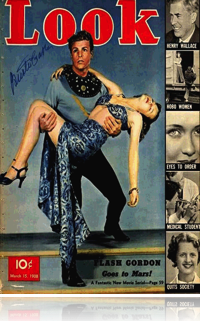
LOOK
Look was a bi-weekly, general-interest magazine published in Des Moines, Iowa, from 1937 to 1971, with more of an emphasis on photographs than articles. A large-size magazine of 11 by 14 inches, it was generally considered the also-ran to Life magazine, which began publication months earlier and ended in 1972.
It is known for helping launch the career of film director Stanley Kubrick, who was a staff photographer.
Gardner “Mike” Cowles, Jr. (1903–1985), the magazine’s co-founder (with his brother John) and first editor, was executive editor of The Des Moines Register and The Des Moines Tribune. When the first issue went on sale in early 1937, it sold 705,000 copies.
Although planned to begin with the January 1937 issue, the actual first issue of Look to be distributed was the February 1937 issue. It was published monthly for five issues (February–May 1937), then switched to bi-weekly starting with the May 11, 1937 issue. Page numbering on early issue counted the front cover as page one. Early issues, subtitled Monthly Picture Magazine, carried no advertising.
The unusual format of the early issues featured layouts of photos with long captions or very short articles. The magazine’s backers described it as “an experiment based on the tremendous unfilled demand for extraordinary news and feature pictures”. It was aimed at a broader readership than Life, promising trade papers that Look would have “reader interest for yourself, for your wife, for your private secretary, for your office boy”.
Within weeks, more than a million copies were bought of each issue, and it became a bi-weekly. By 1948 it sold 2.9 million copies per issue. Circulation reached 3.7 million in 1954, and peaked at 7.75 million in 1969. Its advertising revenue peaked in 1966 at $80 million. Of the leading general interest large-format magazines, Look had a circulation second only to Life and ahead of The Saturday Evening Post, which closed in 1969, and Collier’s, which folded in 1956.
Beginning in 1963, Norman Rockwell, after closing his career with the Saturday Evening Post, began making illustrations for Look.
Look ceased publication with its issue of October 19, 1971, the victim of a $5 million loss in revenues in 1970 (with television cutting deeply into its advertising revenues), a slack economy and rising postal rates. Circulation was at 6.5 million when it closed.
The Look Magazine Photograph Collection was donated to the Library of Congress and contains approximately five million items.
After the closure, six Look employees created a fulfillment house using the computer system newly developed by the magazine’s circulation department. The company, CDS Global, is now an international provider of customer relationship services.
Stanley Kubrick was a staff photographer for Look before starting his feature film career. Of the more than 300 assignments Kubrick did for Look from 1946 to 1951, more than 100 are in the Library of Congress collection. All Look jobs with which he was associated have been cataloged with descriptions focusing on the images that were printed.
James Karales was a photographer for Look from 1960 to 1971. Covering the Civil Rights Movement throughout its duration, he took many memorable photographs, including the iconic photograph of the Selma to Montgomery march showing people proudly marching along the highway under a cloudy turbulent sky.
The magazine is mentioned in numerous films, including The Shawshank Redemption (1994), A Christmas Story, Crazy in Alabama, An Affair to Remember, and The Hoax.



